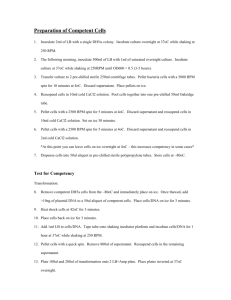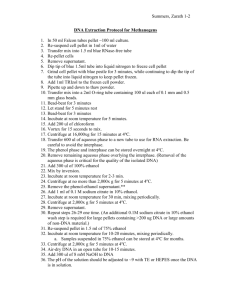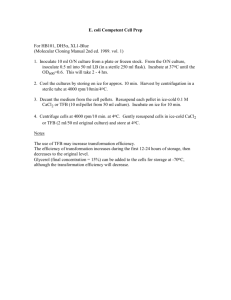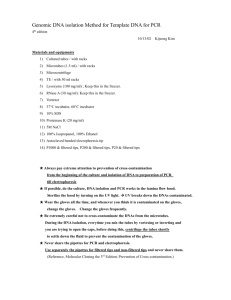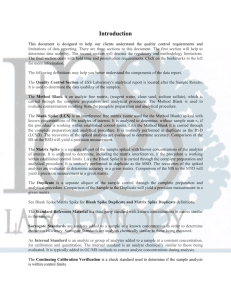DNA Nebulization - Regina O`Neil and Dawn
advertisement
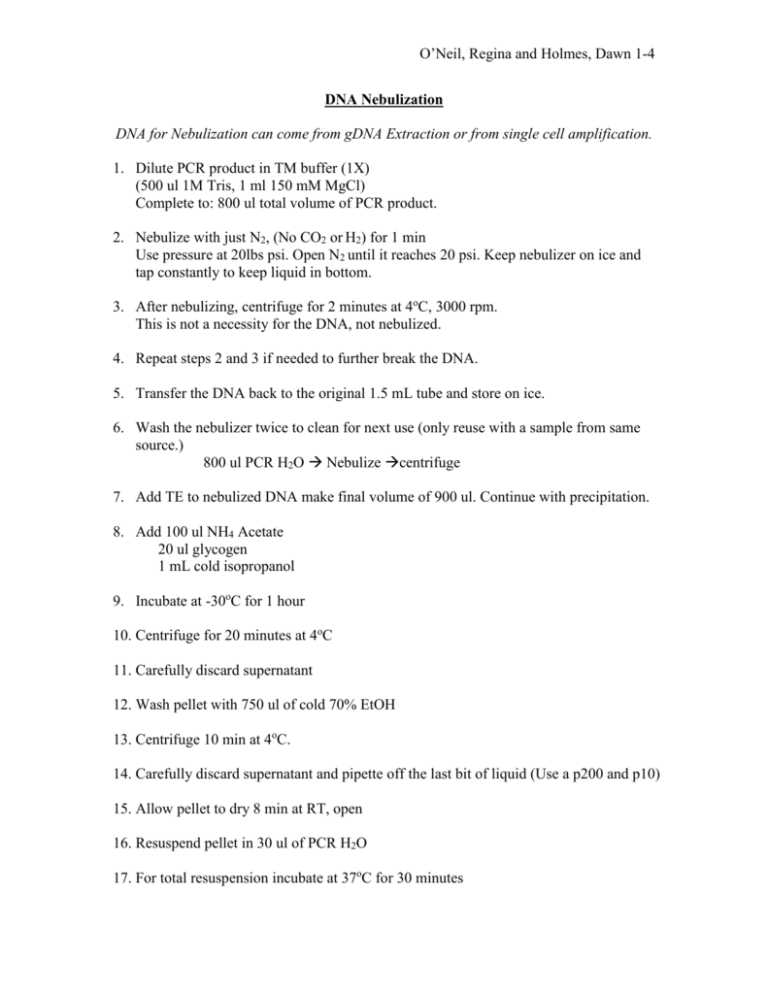
O’Neil, Regina and Holmes, Dawn 1-4 DNA Nebulization DNA for Nebulization can come from gDNA Extraction or from single cell amplification. 1. Dilute PCR product in TM buffer (1X) (500 ul 1M Tris, 1 ml 150 mM MgCl) Complete to: 800 ul total volume of PCR product. 2. Nebulize with just N2, (No CO2 or H2) for 1 min Use pressure at 20lbs psi. Open N2 until it reaches 20 psi. Keep nebulizer on ice and tap constantly to keep liquid in bottom. 3. After nebulizing, centrifuge for 2 minutes at 4oC, 3000 rpm. This is not a necessity for the DNA, not nebulized. 4. Repeat steps 2 and 3 if needed to further break the DNA. 5. Transfer the DNA back to the original 1.5 mL tube and store on ice. 6. Wash the nebulizer twice to clean for next use (only reuse with a sample from same source.) 800 ul PCR H2O Nebulize centrifuge 7. Add TE to nebulized DNA make final volume of 900 ul. Continue with precipitation. 8. Add 100 ul NH4 Acetate 20 ul glycogen 1 mL cold isopropanol 9. Incubate at -30oC for 1 hour 10. Centrifuge for 20 minutes at 4oC 11. Carefully discard supernatant 12. Wash pellet with 750 ul of cold 70% EtOH 13. Centrifuge 10 min at 4oC. 14. Carefully discard supernatant and pipette off the last bit of liquid (Use a p200 and p10) 15. Allow pellet to dry 8 min at RT, open 16. Resuspend pellet in 30 ul of PCR H2O 17. For total resuspension incubate at 37oC for 30 minutes O’Neil, Regina and Holmes, Dawn 2-4 18. Set up and run out resuspended DNA on a gel of 0.8% low melt agarose. The low melt agarose avoids DNA degradation when you are gel extracting. - Run about 1-2 hours at 150 V for separation of bands. Looking for bands between l and 3 kb to be cut out and saved at 4oC overnight. You can also try to work with the large band but these need special plasmids to use for ligation. 19. Gel purify, and resuspend in 50 ul. Save 5ul for 16S PCR, so that you can confirm the population. 20. Ligation Prep: Blunt end repair 45 ul gel purified sheared DNA 7 ul kinase buffer 2 ul BSA 10 ul dNTPS from repliphi kit 5 ul sterile H2O 3 ul T4 DNA polymerase 3 ul klenow DNA polymerase Incubate for 30 minutes at room temp. Heat inactivate at 75oC for 20 minutes. 18. Dephosphorilation Add 10 ul of NEB buffer 3 5 ul Calf Intestine Phosphate (CIP) Incubate for 1 hr at 37oC Heat inactive at 75oC for 20 min. 19. Precipitate sheared, end repaired, dephosphorated DNA: a. Add: 350 ul TE 50 ul NH4 acetate 10 ul glycogen 500 ul Isopopanol b. Vortex briefly c. Incubate at -30oC for 1 hour d. Centrifuge at 4oC for 30 min. e. Wash with 950 ul of 70% cold EtOH. f. Centrifuge at 4oC for 10 minutes g. Discard all of supernatant and dry open at room 4oC for 8 to15 min h. Resuspend in 30 ul H2O i. Incubate at 37oC for 1 hour 20. Check the DNA concentration by spectrophotometry. 21. Clone into pCR- Blunt O’Neil, Regina and Holmes, Dawn 3-4 Calculating Amount of PCR Product to Use: X ng is the amount of PCR product of Y base pairs to be ligated for a 10:1 insert:vector molar ratio. 22. Set up 100:1 Ligation Reaction: Example Insert 1428.6 ng 25.3 uL 10X FastLink Buffer 1X 4 uL 10 mM ATP 1 mM 4 uL Fast Link Ligase 1 uL/15 uL total 2.6 uL pCR Blunt vector 1 uL 1 uL dH2O to complete reaction 3.1 uL Set this reaction up in the smallest possible volume determined by the insert. 23. Incubate in PCR thermocycler on program LIG 18 hrs at 22oC then 15 min at 72oC and hold at 4oC 24. tRNA precipitate 5mL of ligated reactions: 85 mL TE 10mL NH4 acetate 1 mL 1/10 tRNA 100 mL isopropenol o a. Incubate at -30 C for 1 hr b. Spin down at 4oC full speed for 30 min c. Wash pellet with 100 uL 70% cold EtOH, spin down 10 min at 4oC, discard supernatant and air dry for 8 min. d. Resuspend in 2 ul of PCR H2O, and incubate 30 min at 37oC 25. Transforming Competent Cells Use ZeocinTM Selection. Use Low Salt LB agar plates containing 25 ug / ml ZeocinTM. For ZeocinTM to be active, the salt concentration of the bacterial medium must remain low (<90 mM) and the pH must be 7.5. a. Add 2 ul of the TOPO Cloning reaction to one vial of One Shot electrocompetent cells and mix gently. Do not mix by pipetting up and down. Avoid formation of bubbles. b. Carefully transfer cells and DNA to a chilled 0.1 cm electoporation cuvette. Note: The volume of cells should be between 50 and 80 ul to reduce the chance of arcing. O’Neil, Regina and Holmes, Dawn 4-4 c. Electroporate bacteria d. Immediately add 1000 ul or room temperature S.O.C. medium and mix well. e. Shake for at least 1 hour at 37oC to allow expression of the antibiotic resistance genes. f. Spread 20 to 150 ul from each transformation on a pre-warmed low salt LB plate containing 25ug/ml ZeocinTM. g. Incubate plates overnight at 37oC. Recipes: LB (Luria-Bertani) Medium and Plates: 1.0% Tryptone 0.5% Yeast Extraction 1.0% NaCl pH 7.0 Medium: 1. For 1 liter, dissolve 10 g bacto-tryptone, 5 g bacto-yeast extract, and 10 g NaCl in 950 ml deionized water. 2. Adjust the pH of the solution to 7.0 with NaOH and bring the volume up to 1 liter. 3. Autoclave on liquid cycle for 20 minutes at 15 lb./sq. inch. Allow solution to cool to 55oC and add antibiotic if needed. 4. Store at room temperature or at +4oC. LB agar plates: 1. Prepare LB medium as above, but add 15g/L agar before autoclaving. 2. Autoclave on liquid cycle for 20 minutes at 15 lb./sq. in. 3. After autoclaving, cool to ~55oC, add antibiotic (50 ug/ml of either ampicillin or kanamycin), and pour into 10 cm plates. 4. Let harder, then invert and store at +4oC. Low Salt LB Medium: 1.0% Tryptone 0.5% Yeast Extraction 0.5% NaCl pH 7.5 1. For 1 liter, dissolve 10 g tryptone, 5 g yeast extract, and 5 g NaCl in 950 ml deionized water. For plates, be sure to add 15 g/l agar. 2. Adjust the pH of the solution to 7.5 with NaOH and bring the volume up to 1 liter. 3. Autoclave on liquid cycle for 20 minutes at 15 psi. Allow solution to cool to 55oC and add ZeotinTM to a final concentration of 25 ug/ml. 4. Store at room temperature or at +4oC.
